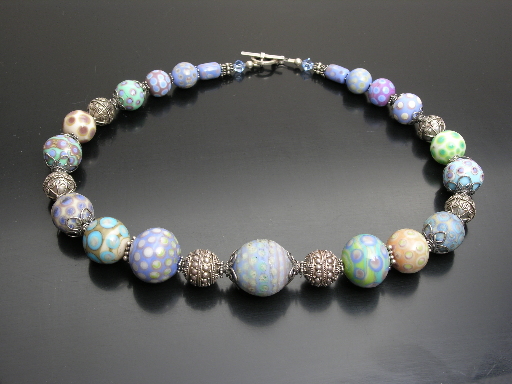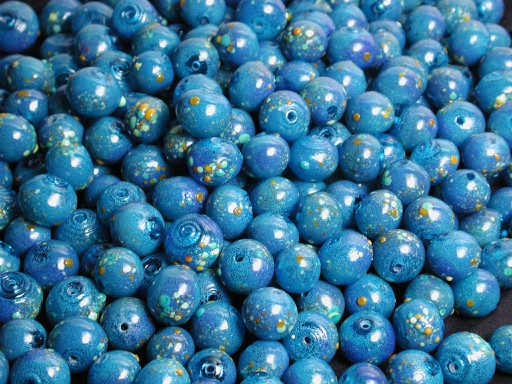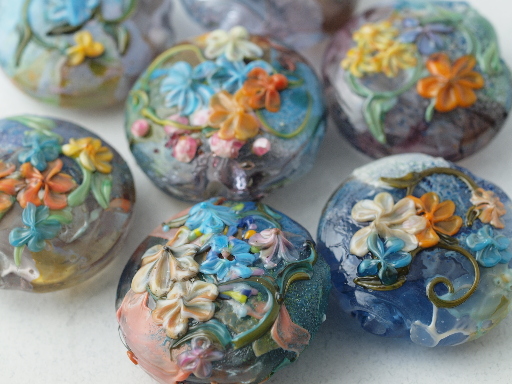Sylvus Tarn— 2016 Gathering Application
Though I didn't start making glass beads until 1996, I have loved them all my life; my earliest memory of beads was picking apart an Indian loom-woven belt of my mother's because some of the seed beads were in colors I had seen nowhere else.
I didn't do much with them, however, until I took a bead embroidery class in the late 80s; and along with other alumni would form the ‘core group’ that eventually became the Great Lakes Beadworkers’ Guild founding board. I had in the meantime begun working at a semi-precious stone bead importer and after a brief introduction to the basics, taught myself how to string beads.
It was through the GLBG that I met Peggy Prielozny, my first teacher, who also encouraged me not only to attend the Society of Glass Beadmakers’ annual conference, but also to sell my work. I was very nervous, as I didn't think it good enough; but it did surprisingly well. That was at Oakland, in 2000; and I was so pleased and inspired that I returned the following year. And the year after that. Not only did I get to learn cool stuff, sell, buy and trade beads, play with torches or watch casual demoes at Open Torch, as a bonus I got to check out new places I'd never had the chance to visit before.
My second teacher, Don Miller, for years taught lampworking in the chemistry labs of UM-Dearborn; and some of us students formed GlassAct, the Southeastern Michigan Glass Bead Guild. A chance remark of Donald Schneider's and Ona Sostakas’ demo of Helga Siemel's technique particularly directed my interest towards what would eventually become my specialty, hollow mandrel wound soft-glass beads.
Back then we didn't have ‘artisan’ glass, so I experimented with PIG, check glass and bullseye, pulling my own thread tests for the former two, as I soon discovered they were only semi-compatible. PIG is probably the worst glass I've ever used, prone to spitting, boiling, stones, and incompatibility even within itself. But at the time, it was also my only source for tan or blue-violet or coke bottle green. Also it was cheap, five dollars a pound; but it was, for all its frustrations, absolutely invaluable in teaching me how to work glass.

Necklace featuring hollow mandrel wound sodalime glass beads, some effetre but primarily PIG (“Perfect International Glass”) Embellished with trailing. Necklace designed and strung by L. Page Brunner with bali and sterling silver components. Completed circa 1998. (N.b.: click on any image for full-size view.)
As a bead stringer for many years, I wanted to make lightweight, durable, wearable jewelry: this drove my design philosophy. Because I tend to think of even focal beads as components, the shapes of my beads have tended to be relatively simple (though making even-walled round hollow beads with good holes is a challenge I don't think I'll ever tire of). Keeping hollow beads round while applying various surface finishes—pixie dust, thompson enamels, frits (many of which I made myself), metallic leafs, as well as a wide assortment of surface trailing—scrolling, floral decorations and of course the classic dots—proved to be a special challenge.
My best friend had also taken up jewelry-making; and to her I not only owe most of what design sense I've developed (my focus always being on color and texture) but also a great many cool bead ideas. Just for example, I never would have persisted with hilight pixie dust on little, hollow beads without her absolute conviction that such beads would blend beautifully with pearls because the heat adequate to stick pixie dust on rapidly cooling hollows is very close to heat that will burn it out.
By 2002 I had enough experience as a production beadmaker for the GLBG to commission me to make their 10th anniversary bead. This involved making a 12 element murrina cane with their initials, founding & current dates. The resulting glob, which I made on a minor, was the size of a tennis ball. My spouse helped me pull the cane. Of course, I had never pulled a mass that large before, and underestimated its heat retention: it kept pulling—and pulling—till I ran out of basement, so I wrapped the cane around a metal ladder! I made just over 300 beads, (with probably enough cane for 3000) and still have fond memories of that project. Later I discovered that black and yellow cane scrap makes excellent cores for realistic leaf cane.

Some of the 300 beads made to commemorate the GLBG's 10th anniversary in 2002. 12mm on average, hollow mandrel wound beads of effetre, with surface embellishments of thompson enamel, artist made frits & 12 element murrina. Completed 12jun2002.
In early 2010, anxious to add sculptural elements to my work, I took a class with Gianno Toso, ordered the (expensive) glassblowing cup shears to recreate the techniques...and got hit by a car, resulting in a broken collarbone the day they arrived. Broken clavicles are not typically serious injuries; they usually self-heal. Mine did not, ultimately requiring three surgeries and two rounds of bone stimulation (resulting in bone spurs) before it healed. Needless to say this affected my ability to make all kinds of art (the injury was on my dominant hand side) but most particularly to work glass, which is at minimum two-handed.
Nevertheless I did slowly regain my skills, and in the meantime, feeling the studio ought to be used, took on an “apprentice”. I enjoy teaching, especially one-on-one or small groups, and though I've taught classes and demoed over the years, it was with Frances that I really felt I had the opportunity to pass along the skills my many teachers and glass friends have shared with me. The boro I was going to play with ‘some day’ became her passion.

Assortment of beads in the lentil floral series. Hollow mandrel wound soda-lime glass beads, pressed into shape with a 1.5" press, embellished with artist made shards; assorted powders; floral trailing. 2014.
My most recent work has focused on sculptural beads, combining presses with hollow beads, and making very, very small mini-hollows (quarter inch being my current minimum.) These latter, little, itty-bitty beads are ideal not only for stringing but also bead embroidery, to which I returned last summer.
In that sense I've come full circle, as bead embroidery was the technique in which I really started exploring my love of beads. My friend Page in December of 2015 completed her metals degree, and we look forward to combining those two media; and Frances and I look forward to playing with a new, bigger torch (though one reason I wish to attend Gathering is to, ahem, gather ideas for enough oxygen to run it.)
2016 marks the 20th anniversary of my first attempts to make glass beads. Glass, tools and most especially techniques available to beadmakers have exploded in the last two decades, in no little measure owing to educational outreach of the ISGB, and it is a major reason the medium has held my interest so consistently: there's always something new to try.
This is what has made attending the Gathering so enjoyable in the past. I look forward to returning.
Curriculum Vitae
Sylvus Tarn
BFA, Eastern Michigan University, 1983.
Exhibitions:
“Fire & Water”, 2014 Synergy, Glassact-SMGBG (Sylvus Tarn) and GLBG (Gail Frederickson)
“Lumieres de la Nuit”, 2012 Synergy Glassact-SMGBG (Sylvus Tarn) and GLBG (Sharon Wagner)
“Collaboration", 2009 Synergy Glassact-SMGBG (Sylvus Tarn) and GLBG (Wendy Zollars)
“Pearls and Purple”, 2008 Dairy Barn
Publications:
Adams, Kimberly, The Complete Book of Glass Beadmaking. Lark Books, 2005. “Triple Hollow”, p. 165
Jamie Hoggsett, Stringing Style: 50+ Fresh Bead Designs for Jewelry. Interweave Press, 2005. Frit & Powder Abstracts, p. 49
1000 Glass Beads: Innovations & Imagination in Contemporary Glass Beadmaking. Lark Books, 2004. Triple Hollows, pp. 100, 208, inside back cover
Jenkins, Cindy: Beads of Glass: The Art & the Artists. Pyro Press, 2003. Triple Hollow, p. 10
BeadWork, Vol. 6, No. 6, Oct/Nov 2003: Dustin Wedekin, “Faux Coral Necklace”, orange curliQ focal, pp. 70–71.
Awards:
2014 Synergy, 3rd prize, Jewelry category.
2002, The Great Lakes Beadworkers’ Guild 10 year Anniversary Commemorative Bead
1993 Shelby Art Fair, 1st Prize, Jewelry Category
Teaching:
Numerous occasions for GlassAct meetings & retreats, 2004–present. Topics include:
- Effective techniques for making and cleaning hollow beads (Demo/Class)
- Making chip charts for Check Glass–with COEs (from my tests) (Guild Project)
- Making sample strands (Guild Project)
- Designing successful color combos for leaf & floral cane; Applying it for a crisp effect. (Demonstration)
- Use your own lampwork bead to make a French Beaded Flower (Class)
- Photographing your beads (Lecture/Class)
Organizations:
ISBG, member 15 years.
GlassAct, the Southeastern Michigan Glass Bead Guild, founding–present. Founding member; created & hosted website for many years; organized bead exchanges, hosted meetings, etc.
Great Lakes Beadworkers’ Guild. Founding member; created logo; edited (& mostly wrote) newsletter for many years; made 300 10yr anniversary beads.
Letters of Recommendation:
Dear ISGB,
This is a letter in support of Sylvus Tarn's application for the ISGB's scholarship. We know Sylvus from the inception of our Guild. She is one of our founding members and has served on the board or in other leadership positions since its inception. She founded our website and hosted it for many years, has been responsible for photographing member beads for guild postcards and the like, teaching us to make hollows, floral cane, as well as assisting with technical issues such as oxygen and propane concerns, etc.
She was one of the first instructors many of us had and started our love affair with glass. When any of us is having a technical problem she is our go to person for answers and happily shares all her knowledge.
We consider her to be one of the founding bead makers for the southeastern bead makers guild. We know that if she attends the Gathering, she will bring back important information to share with our guild.
Thank you for your consideration.
Cindi Brunell
Vice President
Glass Act/Southeastern Michigan Glass Beadworkers Guild\par
adrialis, Inc
3396 Alpine
Troy, MI 48084
To whom it may concern:
I have had the great pleasure and privilege of working with Sylvus Tarn in the capacities of business partner and artistic collaborator for over 20 years. In that time, we have designed and created many memorable works of wearable art which have been shown in numerous galleries and shows. We participated in the Ann Arbor Art Fair for over ten years, showcasing complex, multi-strand designs and earrings which use the durability and clarity of Sylvus’ beads to maximum effect. Her works have been in over 20 galleries throughout the country, retailed in a Paris department store and reside in the personal collection of fashion designer Anna Sui.
The combination of antique and precious components with carefully designed glass focal beads offers an infinite range of styles. Sylvus’ beads drive the designs with expert color theory, perfect shape, lightweight hollow construction and innovative embellishment. I am sure that you are familiar with all of the decorative elements which can be added to the surface of a glass bead. Sylvus brings her experience and education in illustration and textiles to combine these into texture and color, creating patterns with depth and motion. She is able to create small artistic statements that can be abstract and modern, floral and organic or formalist shapes of layered color.
Sylvus is a partner of exceptional creative and professional character. Her attention to detail and proper process results in glass beads that are durable as well as beautiful. She has been in the bead community since the beginning and continues to experiment and innovate. Her latest series of whimsical animal heads echo her love of graphic novels. There has never been an instance when I have said ‘Can you do this?’ and she has said no. She has built up her arsenal of techniques over the decades but has never made work that is derivative. Her goal is to learn and combine techniques in new ways and pass this on to her students, with whom she has generously shared knowledge and encouragement for many years as well.
I hope that you are able to acknowledge the work and contribution of my friend and business partner, Sylvus Tarn, who has shunned the road to national recognition in favor of service to the bead community and personal artistic growth. I can't wait to see what she will come up with next.
Respectfully yours,
L. Page Brunner
adrialis, inc.
Frances Ross
315 W. Cross #3
Ypsilanti, MI. 48197
January 8, 2016
To Whom it may concern,
I am excited to recommend Sylvus Tarn for the ISBG 2016 Gathering Scholarship. I have been studying glass with Sylvus Tarn for 5 years. During this time she has taught me all many aspects of lampwork, ranging from safety and basic techniques to helping me fill out a DBA for my own art business.
Sylvus’ approach to teaching is very effective because she is very good at breaking down a complex process into smaller components. In the beginning of my apprenticeship, I was aware of the components needed to make a good glass bead. I was aware of the big picture of what I could do with glass. Sylvus just broke down each step incrementally so that as a beginner, I would have more success with every step of the process. She was also very generous with giving away all of her tips and tricks for glass. There were never any secret techniques, and when she noticed me struggling with a new technique, she always offered to help.
Another aspect of her teaching style is her willingness to play and to make mistakes. In demos, she shows not only how perform a certain techniques, but how to recover if it fails. She encouraged me to try new techniques, new tools, different types of glass. As a beginner, this always made glass less intimidating. Mistakes were encouraged, and became something be proud of. We laughed at our glass blunders and moved on to the next bead.
In Glassact, the Southeast Michigan Glass Beadworkers Guild, Sylvus helps out a lot behind the scenes, and is a founding member. She always volunteers her time to help out the guild. This includes making beads for group projects, donating beads to charity, doing collaborations with other guild members, and lending her photography skills for guild postcards. When she volunteers herself,she always volunteers me too. When I am skeptical of joining in, she cheerfully says, “It'll be good for you!” By forcing me to become involved in these projects, she has forced me to confront many creative challenges, helping me to grow as an artist.
In Sylvus’ own words, I have graduated from being an apprentice to being a peer. Nonetheless, I can not recommend her enough as a teacher of glass and as a recipient of The ISGB Scholarship. Her passion for teaching is a passion that needs to be shared, so that she can enrich many others lives in the way she has enriched mine.
Sincerely,
Frances Ross
Unless otherwise noted, text, image and objects depicted therein copyright 1996--present sylvus tarn.
Sylvus Tarn